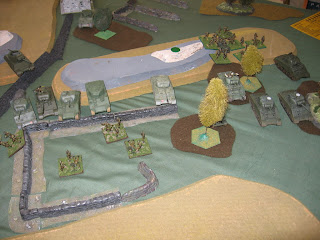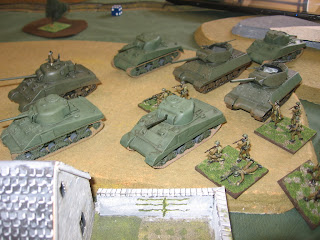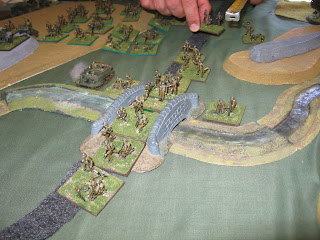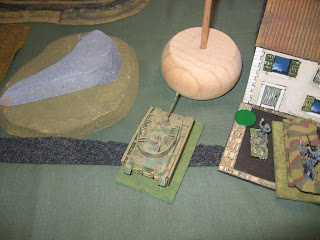We have news that our house is to be demolished and rebuilt post Christchurch earthquake (basically it's uneconomic to repair). So we have started the process of sorting, clearing out and disposal of 20 years of household accumulation. I am in the early stages of this in the wargames room, and I came across these figures: late war American infantry, and a few vehicles and guns. My son Nick had painted these when he was quite young (and made a pretty reasonable job of them, I have to say), and at that time we'd planned to play the Rapid Fire rules set (I'd been playing them for a decade or so, but then we discovered Spearhead). Having moved away from home to continue his study, he decided that he didn't want them, so they have sat quietly in a box for a number of years.
Moving machinations meant their re-discovery, and.. yep, there's enough infantry to do a Spearhead force.
And then there are these boxed kits that have sat there for equally as long - I think that I bought them for Nick for his American force too.
So, along with the plethora of wargamers' fast build M4s etc, this wouldn't be too difficult a project. And it gives me an excuse to build either a Thunderbolt, or a P38 Lightening.. LOVE the P38, comes just after that Tempest on my list of fav WW2 aircraft. Must check out its use in ground support, but I suspect that the Thunderbolt is the more appropriate aircraft for this role.
Friday, April 26, 2013
Wednesday, April 24, 2013
Viznetti - northern Italy, late 1944
It is late 1944 in northern Italy. The German army and the advancing Italian winter have finally halted the allied advance. The German high command has mustered significant forces for a counter-stroke, not knowing that there is one last gasp left in the allied offensive, as the allied command commits the New Zealand Division to one last attack to secure the town of Viznetti, and the crossings over the Moltovo River, swollen with late autumn rains and early snows.
Nick and I played this 20mm Spearhead game, created using Keith McNelly's Scenario Generation System. The German army was taken from the 1944 Panzer Division OOB, while Nick used parts of the New Zealand Division. The lists weren't quite correct, but a part of our aim is to use the available 20mm 'toys'. Consequently, for example, the two German tank battalions were a little too small had we complied strictly with the system. The game was a 'Mutual encounter' using both sides' "encounter/attack" lists.
The German force consisted of two under strength Panzer battalions, a Gepanzert battalion and a Fusilier battalion. High command had also attached two companies of valuable Tiger 1s to support the attack, battalions of 105, 150 and 170mm guns, and was desperately trying to raise some life from the Luftwaffe.
The German commander planned an armoured thrust to capture Viznetti (the 2 sector town in the upper photo). He cross attached the Fusilier battalion and the panther battalion, with the tank heavy battalion taking the west (right) German flank (nearest the camera) to take the snow covered peak and wait in reserve. The Gepanzert Battalion was cross attached with the PzkwIV battalion, with the tank heavy battalion to take Viznetti while the infantry heavy battalion advanced slightly east to wait in a well covered valley in reserve.
The Infantry heavy battalion of Fusiliers was to make a flank attack, supported by the company of Tiger 1s, entering on turn 5.
The Kiwis focused their attack on their left, against the German right. The armour was cross attached with an infantry battalion, with the tank heavy battalion pushing out on their left. The infantry heavy battalion was sent on a flank march hoping to take the German positions in the flank and rear. These troops found the going difficult and arrived late in the day.
The German Panther battalion advanced and took up position on the objective expecting to be held in reserve.
In the centre the other two Kiwi battalions pushed up the central bridge.
They faced a force of PzkwIVs and armoured infantry occupying Viznetti and its surrounds. The centre battalion had the support of a battalion of 150mm guns, and their observer soon found a position in the local church spire from which to call down fire. First blood saw him locate and eliminate the supporting AT 6pdrs from one of the Kiwi battalions.
The Kiwi armour advanced against the German right flank, the supporting M10s eliminating one of the two Panther platoons.
The supporting Pak40 soon took a toll on the attacking M4s.
Turn 5 and the remaining Fusiliers arrive supported by the Tiger company.
The Kiwi commander pushes one battalion across the bridge, intent on assaulting Viznetti.
The Gepanzert troops wait to receive the assault around Viznetti, and quickly became the target of a British UNCLE artillery strike, surviving through sheer good luck. At this stage a vicious counter battery war began. The German commander had a battalion of 170s dedicated to CB, while the Kiwi commander had been allocated a battalion of 5.5" guns in the same roll. The German CB locates one of the two Kiwi 25pdr battalions, eliminates a battery of 25pdrs, and suppresses another. The Kiwis for their part locate the German 150s, and manage to suppress one battery.
At this stage the Kiwi commander calls in a Typhoon strike, and the German troops take the brunt of their feared 'Jabo' attack. One PzkwIV platoon is destroyed.
Pressure builds on the German right, with their supporting Pak40s destroyed.
A fierce gun duel continues between the remaining German Panther platoon and the mass of Kiwi armour.
Meanwhile in the centre a Kiwi battalion pushes across the bridge.
Finally the Kiwi flank attack arrives, and the pressure becomes unbearable on the German right.
The German battalion commander breaks off, intent on pulling back to the next ridge line. This does mean abandoning his objective. At the same time the German commander commits his reserve to swing across from his left to support his endangered right flank. The counter battery war continues, with much of the Kiwi artillery suppressed or destroyed. However casualties are mounting on the German artillery, losing first one, and then a second battery of the 150s.
The German reserve streams across behind Viznetti to reach the right and re-establish a defensive line.
The German left flank force reaches its first objective, the second bridge across the river.
Pressure continues against Viznetti, with the Kiwi commander calling down smoke to screen his advancing infantry.
The Kiwi armour has taken significant casualties but continues to sweep around the old German right flank position, partially claiming the objective.
The German reserve re-establishes the German right on the next ridge line.
The German left flank attack positions itself on its objective, awaiting its next order to attack the Kiwi infantry in the flank.
Finally some of the much promised Luftwaffe support arrives with a Stuka strike. The attack eliminates a Firefly platoon and an infantry platoon as the aircraft dive bomb their targets.
The pressure builds in the centre around Viznetti.
At this stage the Kiwi commander realises that while he has made significant progress, he will be unable to take Viznetti without further support.
We called the game. The Germans held two objectives The Kiwis held one objective, with another two contested, giving each side 4 victory points. An honourable draw and a fantastic game.
The game encompassed much of that is so cool about Spearhead. We had a real game of cat and mouse as we made our plans, each succeeding in applying pressure at the appropriate place. There was a vicious counter battery war, and both sides succeeded in gaining some air support. Nick's Typhoon attack managed to avoid the German AA (I'd taken one AA asset, probably too little for this time of the war), while he had no AA cover himself (not a bad risk to take at this stage of the war). We watched pressure build at critical times, each of us at differing times having to 'fight for our lives' to stay in the game.
This was Nick's first full blown SGS game with all of these dimensions included, and we both had a real ball. Great game, great opponent!!
Nick and I played this 20mm Spearhead game, created using Keith McNelly's Scenario Generation System. The German army was taken from the 1944 Panzer Division OOB, while Nick used parts of the New Zealand Division. The lists weren't quite correct, but a part of our aim is to use the available 20mm 'toys'. Consequently, for example, the two German tank battalions were a little too small had we complied strictly with the system. The game was a 'Mutual encounter' using both sides' "encounter/attack" lists.
The German force consisted of two under strength Panzer battalions, a Gepanzert battalion and a Fusilier battalion. High command had also attached two companies of valuable Tiger 1s to support the attack, battalions of 105, 150 and 170mm guns, and was desperately trying to raise some life from the Luftwaffe.
The German commander planned an armoured thrust to capture Viznetti (the 2 sector town in the upper photo). He cross attached the Fusilier battalion and the panther battalion, with the tank heavy battalion taking the west (right) German flank (nearest the camera) to take the snow covered peak and wait in reserve. The Gepanzert Battalion was cross attached with the PzkwIV battalion, with the tank heavy battalion to take Viznetti while the infantry heavy battalion advanced slightly east to wait in a well covered valley in reserve.
The Infantry heavy battalion of Fusiliers was to make a flank attack, supported by the company of Tiger 1s, entering on turn 5.
The Kiwis focused their attack on their left, against the German right. The armour was cross attached with an infantry battalion, with the tank heavy battalion pushing out on their left. The infantry heavy battalion was sent on a flank march hoping to take the German positions in the flank and rear. These troops found the going difficult and arrived late in the day.
The German Panther battalion advanced and took up position on the objective expecting to be held in reserve.
In the centre the other two Kiwi battalions pushed up the central bridge.
They faced a force of PzkwIVs and armoured infantry occupying Viznetti and its surrounds. The centre battalion had the support of a battalion of 150mm guns, and their observer soon found a position in the local church spire from which to call down fire. First blood saw him locate and eliminate the supporting AT 6pdrs from one of the Kiwi battalions.
The Kiwi armour advanced against the German right flank, the supporting M10s eliminating one of the two Panther platoons.
The supporting Pak40 soon took a toll on the attacking M4s.
Turn 5 and the remaining Fusiliers arrive supported by the Tiger company.
The Kiwi commander pushes one battalion across the bridge, intent on assaulting Viznetti.
The Gepanzert troops wait to receive the assault around Viznetti, and quickly became the target of a British UNCLE artillery strike, surviving through sheer good luck. At this stage a vicious counter battery war began. The German commander had a battalion of 170s dedicated to CB, while the Kiwi commander had been allocated a battalion of 5.5" guns in the same roll. The German CB locates one of the two Kiwi 25pdr battalions, eliminates a battery of 25pdrs, and suppresses another. The Kiwis for their part locate the German 150s, and manage to suppress one battery.
At this stage the Kiwi commander calls in a Typhoon strike, and the German troops take the brunt of their feared 'Jabo' attack. One PzkwIV platoon is destroyed.
Pressure builds on the German right, with their supporting Pak40s destroyed.
A fierce gun duel continues between the remaining German Panther platoon and the mass of Kiwi armour.
Meanwhile in the centre a Kiwi battalion pushes across the bridge.
Finally the Kiwi flank attack arrives, and the pressure becomes unbearable on the German right.
The German battalion commander breaks off, intent on pulling back to the next ridge line. This does mean abandoning his objective. At the same time the German commander commits his reserve to swing across from his left to support his endangered right flank. The counter battery war continues, with much of the Kiwi artillery suppressed or destroyed. However casualties are mounting on the German artillery, losing first one, and then a second battery of the 150s.
The German reserve streams across behind Viznetti to reach the right and re-establish a defensive line.
The German left flank force reaches its first objective, the second bridge across the river.
Pressure continues against Viznetti, with the Kiwi commander calling down smoke to screen his advancing infantry.
The Kiwi armour has taken significant casualties but continues to sweep around the old German right flank position, partially claiming the objective.
 |
| The Kiwi armoured attack arrives at the position previously occupied by the german right flank forces. |
 |
| Kiwi infantry crossing to the front of Viznetti covered by the smoke screen. |
 |
| A firefly and carrier on Nick's left flank (the German right). I included this photo just because I could, showing off Nick's great paint jobs. |
The German reserve re-establishes the German right on the next ridge line.
 |
| The Kiwi armour floods across the objective previously held by the German on their right flank. |
The German left flank attack positions itself on its objective, awaiting its next order to attack the Kiwi infantry in the flank.
 |
| The German armour has popped up onto a ridge line as it adopts its defensive position at the end of its attack arrow. |
Finally some of the much promised Luftwaffe support arrives with a Stuka strike. The attack eliminates a Firefly platoon and an infantry platoon as the aircraft dive bomb their targets.
 |
| Casualties mount on the Kiwi armour. This M4 was destroyed by a German Sdkfz251/9 with its short 75mm gun - something of a lucky shot!! |
The pressure builds in the centre around Viznetti.
 |
| It's tough for both attackers and defenders around Viznetti. The Germans have lost their vital 75 support and one platoon sits suppressed in the wood, while Kiwis are suppressed in the open. |
 |
| The German forces that had broken off on the German right re-establish themselves on the next ridge line back. |
We called the game. The Germans held two objectives The Kiwis held one objective, with another two contested, giving each side 4 victory points. An honourable draw and a fantastic game.
The game encompassed much of that is so cool about Spearhead. We had a real game of cat and mouse as we made our plans, each succeeding in applying pressure at the appropriate place. There was a vicious counter battery war, and both sides succeeded in gaining some air support. Nick's Typhoon attack managed to avoid the German AA (I'd taken one AA asset, probably too little for this time of the war), while he had no AA cover himself (not a bad risk to take at this stage of the war). We watched pressure build at critical times, each of us at differing times having to 'fight for our lives' to stay in the game.
This was Nick's first full blown SGS game with all of these dimensions included, and we both had a real ball. Great game, great opponent!!
Tuesday, April 23, 2013
Nothing like a little Tempest ...
The Hawker Tempest rates as one of my all time favourite WW2 aircraft. No idea why, might be something to do with those war comics I read as a boy. So I was pretty happy when friend Nick gave me an old Revell Tempest V kit to provide some much needed air support for the late war 20mm WW2 British for Spearhead. The age of the kit meant that it came from that era when kits weren't perhaps as finely cast as we would expect today. Having said that, I am not overly happy with my assembly job anyway (regardless of the kit quality). The Normandy stripes were hand painted, and I felt as if I'd made something of a 'dogs breakfast' of them too.
Perhaps more importantly the transfers were so old that it was a struggle to get them off the backing and onto the aircraft intact. I persevered with the wing roundels, hand painted the tail markings and about gave up at that stage, so the model is currently missing the fuselage roundels. Oh well, on the table the visual effect will still be pretty awesome.
Thanks Nick....
And now just the Sturmovik to go in the quest for WW2 air support elements.
Perhaps more importantly the transfers were so old that it was a struggle to get them off the backing and onto the aircraft intact. I persevered with the wing roundels, hand painted the tail markings and about gave up at that stage, so the model is currently missing the fuselage roundels. Oh well, on the table the visual effect will still be pretty awesome.
Thanks Nick....
And now just the Sturmovik to go in the quest for WW2 air support elements.
Subscribe to:
Comments (Atom)
German Uhlans, 1914
World War 1 may not be known for its cavalry, but armies retained extant cavalry forces throughout the war, cavalry played an important part...

-
It's been quite a week of wargaming. Wednesday evening Murray and I completed the Great War Spearhead game in the alps . Wednesday saw u...
-
Painting motivation comes and goes at the moment. While ferreting through that inevitable box (well boxes plural) of unpainted figures and l...
-
During the Great War the eastern and Italian fronts saw fierce fighting across rugged and mountainous terrain. Our preferred WW1 rules syste...










































